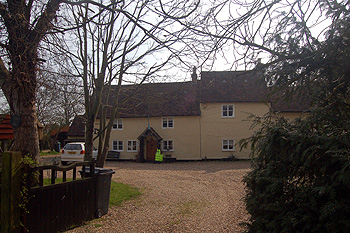
8 to 12 Bell Lane March 2011
8 to 12 Bell Lane was listed by English Heritage in May 1984 as Grade II, of special interest. The building dates from the 18th century. It is of timber framed construction with a colour washed roughcast exterior and a clay tiled roof. Each cottage originally had a single room downstairs. A 20th century lean-to extension stands to the rear.
We are fortunate that three surveys of the parish of Cardington from the late 18th century survive. The first of these was undertaken in 1782 by James Lilburne. He was the parish schoolmaster and later agent for Samuel Whitbread, who owned large estates in the parish and also the sole Enclosure Commissioner for the parish. He produced a list of all the inhabitants of the parish arranged by house and hamlet [P38/28/1]. This was published, with extensive analysis by County Archaeologist David Baker in 1973 as Bedfordshire Historical Record Society Volume 52.
Since publication a second list has been found [P38/28/2]. It carries revisions up to the year 1789. Sadly neither of these surveys includes a map. Finally, in 1794 Lilburne produced another survey [W2/6/1-3] and this one had a map with a key showing where each house was. One can use this to plot the houses of the previous surveys and this work was carried out by John Wood of Bedfordshire County Council’s Conservation Section in October 1982 [CRT130Cardington29].
Unfortunately, because the 1794 map [W2/6/1] is confused at this point, with some unnumbered cottages, it is not easy to say exactly which property is 8 to 10 Bell Lane. One possibility is that it is the cottage occupied in both 1782 and 1794 by Thomas Valentine, presumably the previous owner of the Bell public house. He was a 45 year old dissenter (that is a nonconformist in terms of religion) in 1782, born in Cardington and married to Martha, née Stooks, from oak who was aged 52. Alternatively it might be a tenement of three dwellings, as it was later, which is not numbered on the map. In 1782 the first of these dwellings was in the occupation of William Wells, a 57 year old labourer and a dissenter, who had been born in Wilshamstead and his 64 year old wife Mary who had been born at Cardington. The second dwelling was inhabited by 33 year old Frances, wife of dissenter Joseph Wells who had eloped. Her maiden name had been Martin and she had been born at Clapham. She had four children – Jeremy, aged 12, who was apprenticed in London in 1787, William, aged 10 who was in service with a man named Ibbott in 1787, Elizabeth, aged 7 and Frances aged 6. The whole family moved to London in 1785. The final dwelling was inhabited by William Summerfield, a 50 year old labourer and another dissenter who had been born at North Crawley [Buckinghamshire]. He died on 17th April 1785. His wife was 53 year old Susanna, née Redman, who had been born at Cardington and died on 6th May 1784. Their child was ten year old Hannah who was in service at Widow Woodward’s in the village.
Tithes were, originally, a tenth of one’s household produce, usually an arable crop such as wheat or barley but possibly livestock or manufactured produce such as shoes, given to support the local priest. They were divided into great and little tithes. Great tithes consisted of grain or large animals such as cattle. Little tithes were fruit, vegetables or other small crops and smaller farm animals such as poultry. By the 19th century this archaic practice had long been replaced by monetary tithes. The Tithe Commutation Act of 1836 finally made it compulsory to replace these archaic tithes with monetary payments. The payment was calculated on the seven year average of prices for the particular commodity derived from the land in question and was worked out by the parties involved – parson, landowners or tenants if the land was not owner-occupied. The parish of Cardington, including Cotton End, was assessed for tithes in 1840 [AT9/1]. At that date 8 to 10 Bell Lane was owned by James Malden and occupied by William Taylor and others. The homestead comprised 2 roods, 29 poles and 6d. per annum was payable to the vicar and 4/9 to the impropriator – in other words the holder of the advowson.
The Rating and Valuation Act 1925 specified that every building and piece of land in the country was to be assessed to determine its rateable value. Eastcotts, like most of the county, was assessed in 1927 and the valuer visiting 8 to 12 Bell Lane found the row of three houses owned by R. G. Kean.
Number 8 was occupied by Kean himself. Accommodation comprised a living room, kitchen and a bedroom in the attic. A weather-boarded and felt washhouse and a corrugated iron fowl house stood outside.
Number 10 was in the occupation of L. T. Sims who paid rent of three shillings per week for a living room, kitchen and two bedrooms. Sims was not at home at the time of the visit.
Mrs. Barker lived in Number 12. She paid 2/7 per week for a living room, kitchen and two bedrooms. She also had a weather-boarded and tiled barn outside.